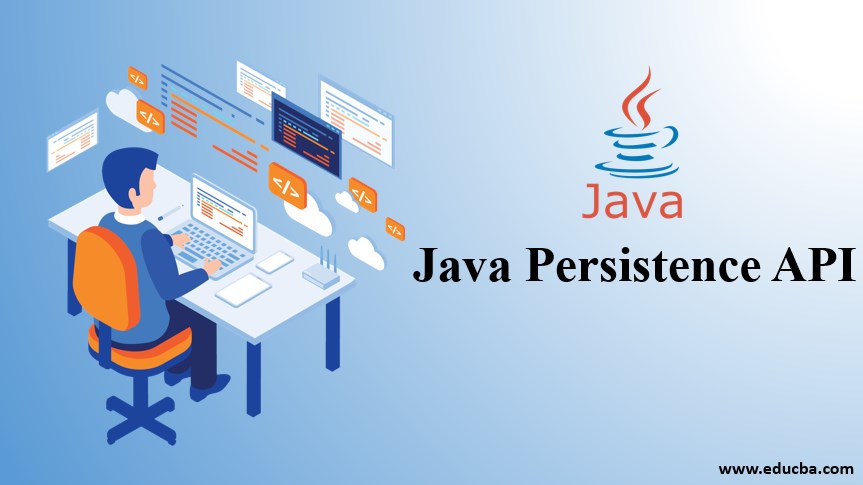Updated March 21, 2023

Introduction to Java Persistence API
As the word “persistence” suggests, JAVA Persistence API has to do the persistence of JAVA objects even when the stemming application of these objects is no more present. The implementation of these objects is majorly present in ORM (object-relational mapping) software like hibernate, EclipseLink, and more. ObjectDB is only the DBMS that provides built-in support of JPA (JAVA Persistence API).
With the help of JPA, a developer can directly work in JAVA data objects rather than getting into the intricacies of the SQL query. This makes the whole process of linking the database to object-oriented language independent of the database’s local query system and injects consistency.
Why do we Need a Java Persistence API?
The main purpose to have JPA is to have persistent objects in the form of JAVA objects which can be used later while interacting with the database. To reduce the impedance and make the front-end application independent of the backend we use ORMs as a middleware. JPA facilitates the use of ORMSs thus making the whole process flexible and modular.
Working
The mapping is being established between JAVA Persistent objects and the database tables. Persistent metadata will be used with the help of the JPA provider to have this functionality in our development. This metadata is defined under annotations of the JAVA class or XML file as well. If we have an XML file in place then the XML file will overwrite the implementation on annotations.
The above application of JPA can be summarized in the form of points below:
- JPA helps in defining SQL like queries thus reducing the dependency on the database management system we are using at the backend. The importance of this flexibility is visible when we do big data migrations.
- JPA facilitates the use of ORM in combination with JAVA objects sometimes by offering database schema automatically created with the help of metadata.
- JPA helps in running queries, update in databases without the use of SQL queries.
- Eliminated the use of JDBC and related methods thus reducing the complexities.
Uses of Java Persistence API
So the Persistent object’s lifecycle should be running even when the main application is not working. This can be achieved by keeping alive the data objects of JPA and then passing them to the database for whichever intent they are kept active. One the work is done these objects can be destroyed. JPA can use instance variable (fields) or getters and setters methods to access these fields. To use setters and getters methods some java beans functionality should be used. Classes, entities, fields, etc are used as key things to have the active JPA objects alive and used while the interaction between front and backend systems.
Any class which should be retained in the database should be annotated with javax.persistence.Entity. This class is called an entity. This entity will be stored in a database table. There is a condition that every entity class should have a primary key, a non-argument constructor and not final. A primary key can be a single field or a combination of two fields depending upon the business requirements. Primary can also be auto-generated by default via @GeneratedValue annotation. This default primary can be then overwritten with the help of our customized logics.
The class in JPA corresponds to the table name of the database by default. The names are the same. Similarly, the “fields” in JPA matches with columns of the table in a database. Although these can be changed with the help of annotations like given below:
@Table (name=”CHANGEDNAME_TABLE”)
@Column (name=”newColumnName”).
We can also maintain relationships with the help of JPAs in the absence of SQL queries. The annotation “mappedBy” is used for this. These mappings can be of type “one to one”, “one to many”, “many to many” or “many to one”.
@ManyToMany (mappedBy=”attributes_are_defined_here”).
There is also a library “javax.persistence.EntityManager” to manage the lifecycle of a persistent object in the database. It helps to find, persist and destroy the objects. For most of the JAVA EE application, the entity manager is automatically inserted. The entity manager is created on top of “EntityManagerFactory” which is configured with the help of the persistence unit. There is a file maintained called “persistence.xml” to store all the necessary mappings required to map database and JPA objects. This file becomes the basic file to implement many functionalities between java objects and database tables.
Advantages
Some important advantages of JPA over others are:
- It eliminates the use of SQL queries and JDBC connectors thus reducing the complexities of database programming.
- Significantly reduces the dependency on the database system one is using at the backend. This is very useful at the time of DBMS migrations saving a lot of energy and effort.
- The code looks clean and the developer only needs to know JAVA rather than learning SQL or PL/SQL.
Skills Required
The skills required to learn and which will help one grab the JPA functionality easily are:
- Basic understanding of JAVA language, use of libraries, method, objects, classes, and functions will be useful for one to implement JPAs.
- Basic understanding of SQL query language and how ORM works will help in understanding the use of JPA.
- One can understand XML mappings to check how data flow is designed between front and backend systems.
Conclusion
Hence JPA is one of the very useful implementations of SQL queries in the form of JAVA objects. ORMs are built on top of the JPA concept itself. This makeup very good share in the market due to easy implementation and advantages.
Recommended Articles
This is a guide to Java Persistence API. Here we discuss the Introduction and the Uses of Java Persistence API in various fields along with advantages and the skills required to learn Java Persistence API. You may also look at the following articles to learn more –

